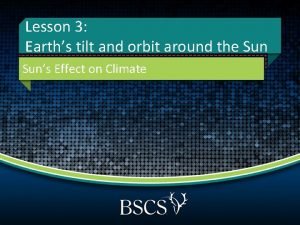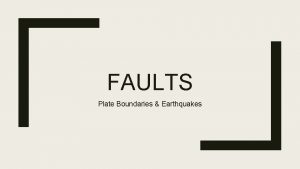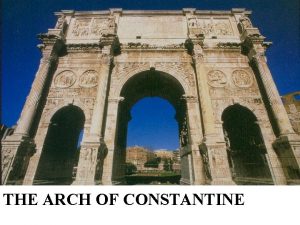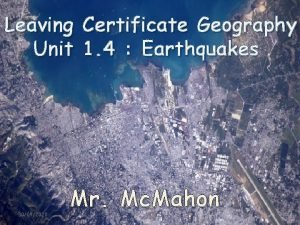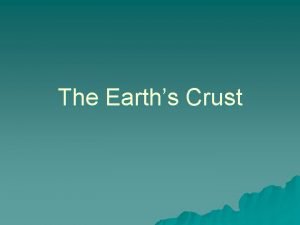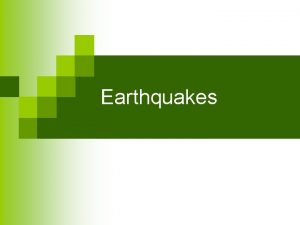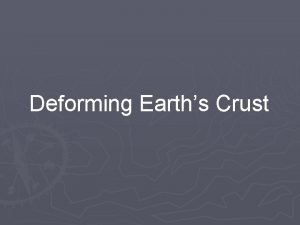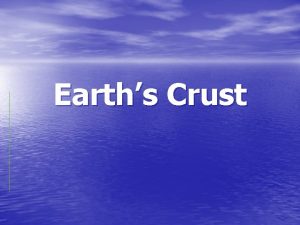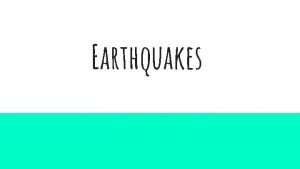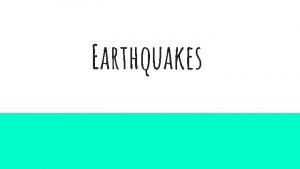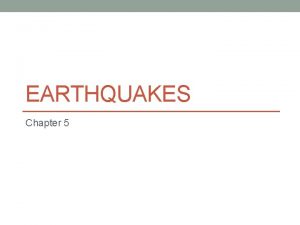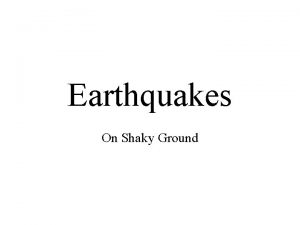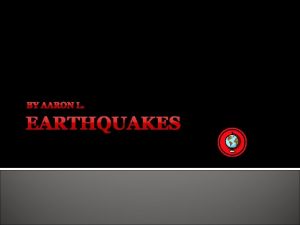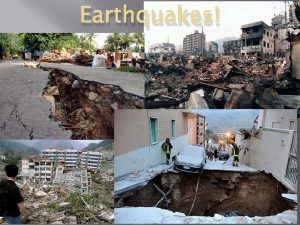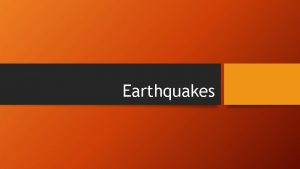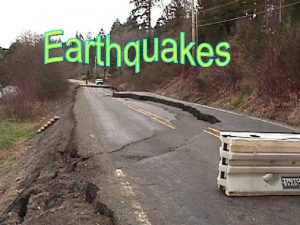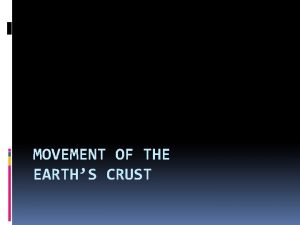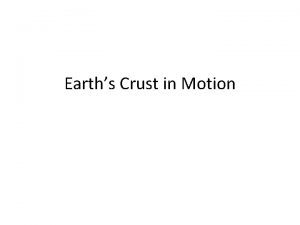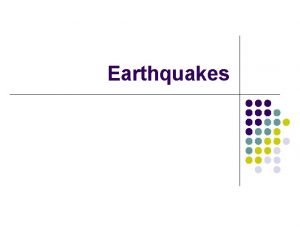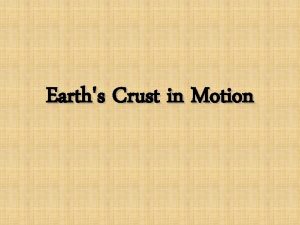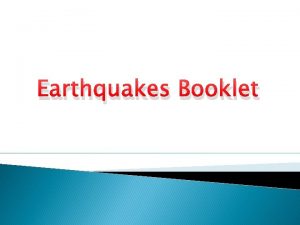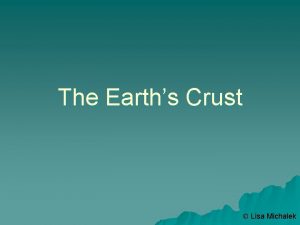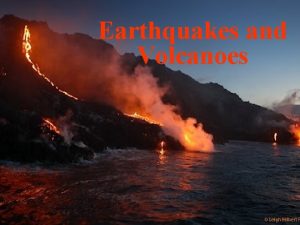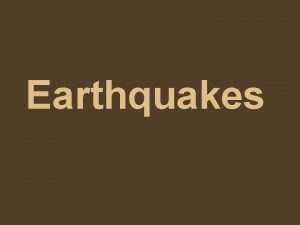Earthquakes Shaking of the earths crust due to

































- Slides: 33

Earthquakes Shaking of the earth’s crust due to movement along a fault.


3 types of faults Normal fault – One block drops down in relation to the other block

Normal fault

Normal fault

Reverse fault – One block is pushed up over another (thrust fault)

Reverse fault

Strike slip fault – No vertical movement block slide sideways past one another.

Strike slip fault

NORMAL FAULT REVERSE FAULT TRANSFORM FAULT

3 types of earthquake waves P wave – Primary wave (compressional wave) – Vibrates in the same direction as wave travel – Travels the fastest – Can travel through solids, liquids, gases

3 types of earthquake waves S wave – Secondary wave (shear wave) – Vibrates at right angles to direction of wave travel – Travels 2 nd fastest – Can only travel through solids

3 types of earthquake waves L wave – Surface wave – vibrates up and down like waves on the water. – Travels slowest

Vocabulary Epicenter – point on the earths surface directly above where the earthquake occurs Focus – Point in the earth where the earthquake actually occurs

Vocabulary (cont. ) Seismograph – an instrument that records earthquake waves


Measuring Earthquakes Mercalli scale – Based on damage to structures and local environment Richter scale – Measures magnitude or size of the earthquake – amount of energy released – Logarithmic scale – each step is 10 times larger than the one before it

Mercalli scale


Determining Richter Magnitude

Locating an epicenter P and S waves travel at different speeds The time between the arrival of the P wave and the S wave is called the lag time The further you are from the epicenter the greater the lag time

How is an Earthquake’s Epicenter Located? – After an earthquake, the difference in arrival times at a seismograph station can be used to calculate the distance from the seismograph to the epicenter. (Lag Time)

How is an Earthquake’s Epicenter Located? Time-distance graph showing the average travel times for P- and S-waves. The farther away a seismograph is from the focus of an earthquake, the longer the interval between the arrivals of the P- and Swaves

How is an Earthquake’s Epicenter Located? Three seismograph stations are needed to locate the epicenter of an earthquake Each circle represents the epicenter distance The intersection of the circles locates the epicenter

Which station would have the largest lag time? ?

P Wave Travel Time The time it took for the P wave to get to your seismic station – If you know your distance (ex 4000 km) use the graph to determine the time it took for the p wave to travel that distance – 7 minutes

Origin Time When the Earthquake actually happened. You know when you first felt the p waves (p arrival time) Determine the p travel time from the epicenter distance P arrival time – p travel time = Origin time

Earthquake Damage Liquefaction – Loose soil takes on the properties of a liquid because it vibrates so much Foreshocks – small earthquakes that happen just before the main quake Aftershocks - small earthquakes happen after the main earthquake as ground settles Tsunami – huge ocean wave caused by undersea earthquake

Interior of the earth

Study of the earth’s interior Seismic waves will move at different speeds, are refracted, and sometimes will not travel through layers depending on their composition and state of matter. – S waves do not travel through liquids******

Study of the earth’s interior Wave travel and refraction

Earthquake waves and shadow zones

 Earth's layers foldable
Earth's layers foldable Earths crust
Earths crust Most abundant element in earth's crust
Most abundant element in earth's crust Plasticity in earth's layers
Plasticity in earth's layers Characteristics of the percussion family
Characteristics of the percussion family We will not be moved you're standing with us
We will not be moved you're standing with us Myoclonic vs tonic clonic seizure
Myoclonic vs tonic clonic seizure Pentacosiomedimni cavalieri zeugiti teti
Pentacosiomedimni cavalieri zeugiti teti Conservazione del moto
Conservazione del moto Quadrilateri con due lati opposti paralleli
Quadrilateri con due lati opposti paralleli Procedural due process vs substantive due process
Procedural due process vs substantive due process Earths roation
Earths roation Whats earths moon called
Whats earths moon called Spring earth tilt
Spring earth tilt Earths orbit seasons
Earths orbit seasons What is luna moon
What is luna moon Whats a natural satellite
Whats a natural satellite Earth's thickest layer
Earth's thickest layer Atmospheric layers definition
Atmospheric layers definition What does earths tilt do
What does earths tilt do Brown earth soil ireland
Brown earth soil ireland Continental drift theory notes
Continental drift theory notes Biome near the equator
Biome near the equator Earths early atmosphere contained
Earths early atmosphere contained What is the true shape of earth
What is the true shape of earth Earths boundaries
Earths boundaries Earths physical features
Earths physical features The earth's layers foldable
The earth's layers foldable Earths interior
Earths interior Earths major crustal plates
Earths major crustal plates The emperor constantine i recycled sculpture
The emperor constantine i recycled sculpture 4 spheres of the earth
4 spheres of the earth Earths honey
Earths honey The richer scale
The richer scale



















